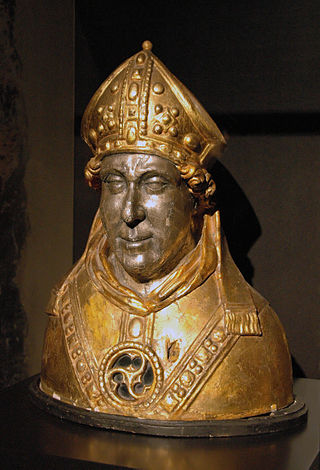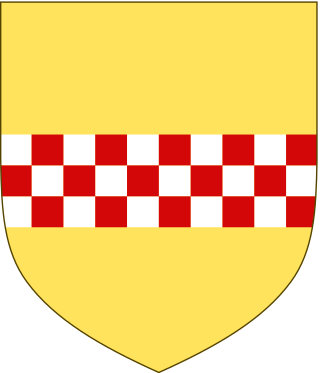
Berg was a state—originally a county, later a duchy—in the Rhineland of Germany. Its capital was Düsseldorf. It existed as a distinct political entity from the early 12th to the 19th centuries.

The County of Mark was a county and state of the Holy Roman Empire in the Lower Rhenish–Westphalian Circle. It lay on both sides of the Ruhr River along the Volme and Lenne rivers.

Count Engelbert II of Berg, also known as Saint Engelbert, Engelbert of Cologne, Engelbert I, Archbishop of Cologne or Engelbert I of Berg, Archbishop of Cologne was archbishop of Cologne and a saint; he was notoriously murdered by a member of his own family.

Henry IV was the duke of Limburg and count of Berg from 1226 to his death. He was the son of Waleran III, count of Luxembourg and duke of Limburg, and Cunigunda, daughter of Frederick I, Duke of Lorraine.

Adolf IV of Berg count of Berg from 1132 until 1160 and of Altena, son of Adolf III of Berg count of Berg and Hövel. He married (1st) Adelheid von Arnsberg, a daughter of Heinrich count von Rietberg; then (2nd) Irmgard (?) von Schwarzenberg, a daughter of Engelbert von Schwarzenberg.

The House of La Marck was a noble family, which from about 1200 appeared as the counts of Mark.
Friedrich II of Berg, was Archbishop of Cologne from 1156 until his death in 1158.

The House of Limburg-Stirum, which adopted its name in the 12th century from the immediate county of Limburg an der Lenne in what is now Germany, is one of the oldest families in Europe. It is the eldest and only surviving branch of the House of Berg, which was among the most powerful dynasties in the region of the lower Rhine during the Middle Ages. Some historians link them to an even older dynasty, the Ezzonen, going back to the 9th century.

Adolph III of the Marck was the Prince-Bishop of Münster from 1357 to 1363, the Archbishop-Elector of Cologne in 1363, the Count of Cleves from 1368 to 1394, and the Count of Mark from 1391 to 1393.

The County of Virneburg was a territory of the Holy Roman Empire in the region of the Eifel in present-day Rhineland-Palatinate.
Gerhard V of Jülich, Count of Jülich (1297–1328), was the youngest son of William IV, Count of Jülich and Richardis of Guelders, daughter of Gerard III, Count of Guelders.
William IV, Count of Jülich was the son and heir of William III of Jülich and Mathilde of Limburg, daughter of Waleran III, Duke of Limburg.
Adolf VII of Berg was the eldest son of Henry IV, Duke of Limburg and Irmgard of Berg.
Adolph II of the Marck was Count of the Marck.
Eberhard I was a German nobleman. He was Count of the Mark from 1277 until his death. He was the son of Engelbert I, Count of the Mark and Kunigunde of Blieskastel, daughter of Count Henry I of Blieskastel.
Margaret of Cleves, also spelled Margaretha or Margarethe was the wife of Count Adolf II of the Marck and mother of Adolf III of the Marck. She was a daughter of Count Dietrich VIII of Cleves and Margaret of Guelders, who was a daughter of Reginald I of Guelders.
Engelbert I, Count of the Mark was a German nobleman. He was the ruling Count of the Mark from 1249 until his death.

The house of Limburg Hohenlimburg took its name in the 12th century from the county of Limburg on the river Lenne in today's Germany. After Diederick of Isenberg had claimed part of the former property of his father Frederik of Isenberg with the help of uncle Duke Hendrik of Limburg, he built the Hohenlimburg castle on the river Lenne. At fifty years of age, his third son Everhart, closest descendant of the original holder, succeeded him in the county. Mentioned count, in original kept charters, since 1276 together with his father. It was clear that the future male-line primogeniture was granted. Everhard is the ancestor of the family branch of the counts of Limburg Hohenlimburg and Broich. His first brother Henry died young and second Johan (1247-1277), died at the age of thirty, left three children. Johan is the ancestor of the house Lords of Limburg Stirum. The Counts of Limburg Hohenlimburg and Broich were not count by name with a late 17th century certified title but actually ruled the county of Limburg-Lenne since the 13th century, until the first quarter of the 16th century. The last count Johan (1464-1511) who had no descendants of his own. None of his only two male relatives, cousins Diederick and Adolf of Limburg, sons of his former godfather Johan of Limburg (1421-1472), had inheritance rights, as explained below. To prevent the family of his former wife Von Neuenahr from taking the county, Count Johan adopted his cousin Irmgard of Sayn at her marriage to Winrich of Daun. She and her husband inherited the county.

Frederick von Saarwerden was archbishop-elector of Cologne as Frederick III from 1370 to 1414. Through the promotion of his great-uncle, Archbishop Kuno II of Falkenstein of Trier, Frederick von Saarwerden was elected archbishop of Cologne at the age of 20, which the Pope in Avignon also confirmed two years later after some misgivings. Frederick found the archbishopric completely plundered by his two predecessors of the County of Mark, Adolf and Engelbert, and had himself promised high payments to the Curia on the occasion of his election. Nevertheless, with the help of his very rich great-uncle Kuno, he succeeded in paying off the debts of the archbishopric within a few years.











